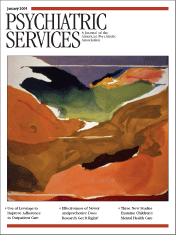To the Editor: In the November 2004 issue, Dr. Jones and associates (
1) reported on the prevalence and severity of chronic physical health problems of persons with chronic mental illness. They highlighted the importance of pulmonary disease among such patients. In their study chronic pulmonary disease was the most prevalent physical health problem (31 percent incidence) and was the most frequent comorbid condition (50 percent or more of patients with eight other health conditions were also treated for respiratory conditions). Similar results have been reported previously, including a British study that concluded that respiratory disorders were responsible for substantial excess mortality among patients with psychotic illnesses (
2).
Despite these findings it would appear that clinicians frequently do not pay adequate attention to the evaluation of oxygenation during medical examinations of patients with chronic mental illness. Recommendations for the assessment of psychiatric patients who need medical clearance generally advise physical examination and routine laboratory tests, including a toxicologic screen, CBC, electrolytes, BUN, creatinine, glucose, calcium, CPK, and prothrombin time (
3). If such testing does not explain the patient's symptoms, a cranial CT is performed, followed by a lumbar puncture if the patient has a fever. However, none of these ancillary studies reflect the degree of oxygenation. Decreased oxygenation—hypoxia—may present with a number of signs and symptoms, including inattentiveness, lethargy, poor judgment, restlessness, insomnia, agitation, euphoria, and confusion, before progressing to more obvious signs of cerebral impairment (
4). These symptoms are nonspecific and may be incorrectly attributed to the presentation or exacerbation of a mental disorder, particularly if the patient has a known history of mental illness.
In view of the reported incidence of pulmonary disorders among persons with chronic mental illness, it could be argued that this group's medical clearance should include some form of assessment for decreased oxygenation. For a screening test, pulse oximetry can be performed simply and noninvasively in less than 30 seconds. A sensor placed on the patient's finger or earlobe measures the percentage of hemoglobin that is saturated with oxygen. An oxygen saturation of less than 90 percent suggests hypoxia. Pulse oximeters frequently detect problems with oxygenation before they are noticed clinically. Thus an abnormality by pulse oximetry should prompt an immediate search for an underlying cause of hypoxia.
It should be noted that oximetry results may be normal in acute dyspnea, particularly if the patient is able to compensate temporarily by hyperventilation. Oximeters give no information about the level of CO2 and have limitations in the assessment of patients who are developing respiratory failure because of CO2 retention. Tests such as arterial blood gas measurements are more sensitive in detecting impaired gas exchange, but they are invasive, may produce discomfort, and take longer to complete.
For patients with chronic mental illness who present with changes of mental status, decreased oxygenation should be part of the differential diagnosis on the basis of findings described above. Pulse oximetry could serve as a simple, quick, and painless screening test for decreased oxygenation provided its limitations are kept in mind (
5).

